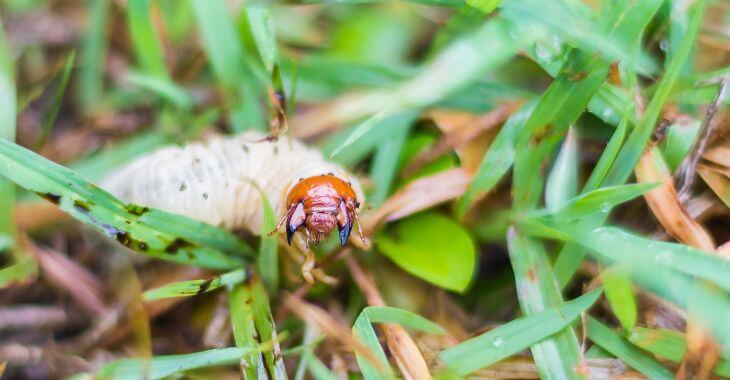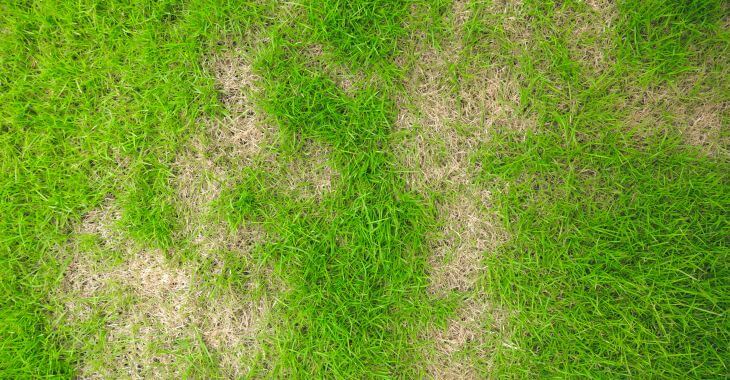What to Do for a Grub Worm Lawn Infestation

Is your lawn struggling to thrive? If you have fertilized, watered and pampered your lawn, but it has patches of dead grass or weed problems, you may have a pest problem. One of the most common lawn pests is the grub worm. These larvae feed on grass and if they are left unchecked, they can ruin your entire lawn. Learn more about the grub worm – how to identify it, treatments and infestation prevention – to keep your lawn healthy.
What Is a Grub Worm?
There are over a thousand different types of scarab beetles in the U.S. and many of them have larvae that can live in your lawn. A grub worm is not really a worm, but the larvae of one of the many beetles that can feed off grass and other plants in your yard. Grub worms that prefer grass as food are called lawn grubs and may be the larvae of June, Japanese and African black beetles to name a few. They live in the soil and feed off the grass roots during the spring and summer. They eventually build cocoons to transform into beetles.
What Does a Grub Worm Look Like?
A grub worm hatches in the spring from eggs laid by beetles. What does a grub worm look like? Grub or lawn worms can vary from a quarter of an inch to two-inches long. Most are white with brown heads and are C-shaped, living in the soil to feed off the grass roots and thatch in your lawn. Lawn worms are more prevalent in the warmer climate areas in the southern U.S. – harsh winters can kill many of these types of beetles and grubs.
To find out if you have grub worms impacting your lawn, you may need to dig into your lawn. Choose a brown patch of lawn and cut out a square foot of turf and soil, about three-inches deep. Check the soil for lawn grubs – it is normal to find some, but if you have 10 or more in this sample, you could have an infestation on your hands. Other signs of lawn grub infestation in your lawn include:
- Spongy turf
- Excessive birds, moles and raccoons attracted to your yard – they are feeding on the grubs
- More weeds – weakened grass allows weeds to take hold
- Patches of dead grass
- Turf can be pulled easily – the grass blades have been chewed at the roots
To stop these grubs from ruining your lawn, you need to begin treatment with grub worm killer to protect your grass from these small pests.
What Type of Grub Worm Killer Should I Use?
There are two main options for fighting a grub worm infestation – natural treatments or chemical pesticides. Natural treatments are very effective, but they can take longer than using chemical grub worm killer. The natural options include using nematodes, a type of worm parasites that will kill grub worms or introduce a milky spore to your lawn. Both will control grub worms, but it can take a year or longer to effectively diminish the lawn grub population. The benefit is that it will not kill other beneficial insects in your lawn.
Another natural option is to dry out your lawn. If you have a drought-resistant grass, a few weeks without water will not hurt it, but it will impact the grubs in the soil. Not watering your grass for 3-4 weeks in the summer will result in yellow or brown grass and kill many of the lawn grubs in your soil. A deep watering afterward will bring most grass back to life without grubs.
For faster relief from a lawn grub infestation, you can choose a chemical grub worm killer. There are many chemical treatments that can cure a lawn grub infestation – most contain carbaryl and trichlorfon. Depending on the product, it may be used at different times of year to kill lawn grubs. Follow the instructions to rid your lawn of grub worms.

Once you have your grub worm infestation under control, you can use preventive chemical treatments or one of the natural options. Keep in mind that chemical treatments can be harmful to other insects that help maintain healthy soil or to some wildlife in the area. You can talk to your local landscaper about safe lawn grub treatments to keep your lawn safe from these grass pests while maintaining a healthy environment for beneficial insects.
When you notice signs of unhealthy grass, it is important to check to see if you have grub worms in your lawn. Controlling lawn grubs can help keep your grass healthy and keep these hungry beetle larvae from ruining your beautiful lawn. For help with lawn grubs and other pests that impact your lawn, contact a local landscaper for effective lawn grub and insect treatments.

